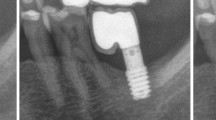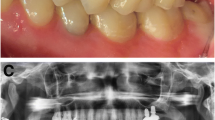Abstract
The aim of this paper was to demonstrate the treatment outcomes following immediate functional loading concept of short implants inserted for single tooth replacement in the posterior maxilla. The study was performed on 63 patients who received short (6 mm) implants for single tooth replacement in the posterior maxilla. Forty-eight patients underwent immediate functional concept, whereas 15 of the implants were loaded 3 months after insertion. The patients were evaluated for up to 5 years after prosthesis completion. The endpoints included the evaluation of implant survival rate, crown length, bone resorption, plaque accumulation (PI), bleeding on probing (BOP), periodontal probing depth (PPD) and assessment of oral health impact profile (OHIP). At the end of the follow-up period of 5 years, three implants (6.3%) from the immediate loading group have failed during the observation period. Bone loss was significantly lower in the delayed loading group compared to the immediately loaded implants. At the end of the second year, BOP values were higher in the immediately loaded group. Throughout the observation period, PI values in the group with immediate loading were higher. PPD increased consistently and during the first 3 years in the immediate loading group. As a conclusion, short implants inserted for single tooth replacement at the posterior maxilla presented with satisfactory clinical outcomes in both immediate and delayed loading concepts. However, immediately loaded implants presented with an increased bone loss and higher BOP values. As assessed by the OHIP score, a subjective improvement was observed in both groups without significant differences.









Similar content being viewed by others
References
Cossellu G, Farronato G, Farronato D, Ceschel G, Angiero F. Space-maintaining management in maxillary sinus lifting: a novel technique using a resorbable polymeric thermo-reversible gel. Int J Oral Maxillofac Surg. 2017;46(5):648–54.
Tallarico M, Meloni SM, Xhanari E, Pisano M, Cochran DL. Minimally invasive sinus augmentation procedure using a dedicated hydraulic sinus lift implant device: a prospective case series study on clinical, radiologic, and patient-centered outcomes. Int J Periodontics Restor Dent. 2017;37(1):125–35.
Gutwald R, Haberstroh J, Kuschnierz J, Kister C, Lysek DA, Maglione M, Xavier SP, Oshima T, Schmelzeisen R, Sauerbier S. Mesenchymal stem cells and inorganic bovine bone mineral in sinus augmentation: comparison with augmentation by autologous bone in adult sheep.Br. J Oral Maxillofac Surg. 2010;48(4):285–90.
He J, Zhao B, Deng C, Shang D, Zhang C. Assessment of implant cumulative survival rates in sites with different bone density and related prognostic factors: an 8-year retrospective study of 2,684 implants. Int J Oral Maxillofac Implants. 2015;30(2):360–71.
Cinar D, Imirzalioglu P. The effect of three different crown heights and two different bone types on implants placed in the posterior maxilla: three-dimensional finite element analysis. Int J Oral Maxillofac Implants. 2016;31(2):e1–10.
Anitua E, Piñas L, Murias-Freijo A, Alkhraisat MH. Rehabilitation of atrophied low-density posterior maxilla by implant-supported prosthesis. J Craniofac Surg. 2016;27(1):e1–2.
Anitua E, Flores J, Flores C, Alkhraisat MH. Long-term outcomes of immediate loading of short implants: a controlled retrospective cohort study. Int J Oral Maxillofac Implants. 2016;31(6):1360–6.
Thoma DS, Zeltner M, Hüsler J, Hämmerle CH, Jung RE EAO Supplement Working Group 4-EAO CC 2015 Short implants versus sinus lifting with longer implants to restore the posterior maxilla: a systematic review. Clin Oral Implants Res. 2015;26(Suppl 11):154–69.
Sogo M, Ikebe K, Yang TC, Wada M, Maeda Y. Assessment of bone density in the posterior maxilla based on Hounsfield units to enhance the initial stability of implants. Clin Implant Dent Relat Res. 2012;14(Suppl 1):e183-7.
Martinez H, Davarpanah M, Missika P, Celletti R, Lazzara R. Optimal implant stabilization in low density bone. Clin Oral Implants Res. 2001;12:423–32.
Lemos CA, Ferro-Alves ML, Okamoto R, Mendonça MR, Pellizzer EP. Short dental implants versus standard dental implants placed in the posterior jaws: a systematic review and meta-analysis. J Dent. 2016;47:8–17.
World Health Organization. Oral Health Surveys, Basic Methods. 4th ed. Geneva: WHO Press; 1997. pp. 26–9 (Oral Health Assessment Form).
Ayna M, Gülses A, Açil Y. Comprehensive comparison of the 5-year results of all-on-4 mandibular implant systems with acrylic and ceramic suprastructures. J Oral Implantol. 2015;41(6):675–83.
Brägger U. Radiographic parameters for the evaluation of peri-implant tissues. Periodontol 2000. 1994;4:87–97.
Brägger U. Use of radiographs in evaluating success, stability and failure in implant dentistry. Periodontol 2000. 1998;17:77–88.
Mombelli A, Van Oosten MAC, Schürch E, Lang N. The microbiota associated with successful or failing osseointegrated titanium implants. J Oral Microbiol Immunol. 1987;2:145–51.
John MT, Miglioretti DL, LeResche L, Koepsell TD, Hujoel P, Micheelis W. German short forms of the oral health impact profile. Community Dent Oral Epidemiol. 2006;34:277–88.
Misch CE, Perel ML, Wang HL, Sammartino G, Galindo-Moreno P, Trisi P, Steigmann M, Rebaudi A, Palti A, Pikos MA, Schwartz-Arad D, Choukroun J, Gutierrez-Perez JL, Marenzi G, Valavanis DK. Implant success, survival, and failure: the International Congress of Oral Implantologists (ICOI) Pisa Consensus Conference. Implant Dent. 2008;17:5–15.
Degidi M, Nardi D, Piattelli A. Immediate versus one-stage restoration of small-diameter implants for a single missing maxillary lateral incisor: a 3-year randomized clinical trial. J Periodontol. 2009;80(9):1393–8.
Kim SJ, Ribeiro AL, Atlas AM, Saleh N, Royal J, Radvar M, Korostoff J. Resonance frequency analysis as a predictor of early implant failure in the partially edentulous posterior maxilla following immediate nonfunctional loading or delayed loading with single unit restorations. Clin Oral Implants Res. 2015;26(2):183–90.
Abboud M, Koeck B, Stark H, Wahl G, Paillon R. Immediate loading of single-tooth implants in the posterior region. Int J Oral Maxillofac Implants. 2005;20(1):61–8
Esposito M, Ardebili Y, Worthington HV. Interventions for replacing missing teeth: different types of dental implants. Cochrane Database Syst Rev. 2014;22:CD003815.
Schrott A, Riggi-Heiniger M, Maruo K, Gallucci GO. Implant loading protocols for partially edentulous patients with extended edentulous sites—a systematic review and meta-analysis.Int J Oral Maxillofac Implants. 2014;29(Suppl):239–55.
Alvira-González J, Díaz-Campos E, Sánchez-Garcés MA, Gay-Escoda C.Survival of immediately versus delayed loaded short implants: a prospective case series study. Med Oral Patol Oral Cir Bucal. 2015;20(4):e480–8.
Boni W, Delle Donne U, Corradini G, Tettamanti L, Tagliabue A. Short versus standard length implants: a case series analysis. J Biol Regul Homeost Agents. 2015;29(3 Suppl 1):1–5.
Muelas-Jiménez MI, Olmedo-Gaya MV, Manzano-Moreno FJ, Reyes-Botella C, Vallecillo-Capilla M. Long-term survival of dental implants with different prosthetic loading times in healthy patients: a 5-year retrospective clinical study. J Prosthodont. 2017;26(2):99–106.
Neldam CA, Pinholt MS. State of the art of short dental implants: a systematic review of the literature. Clin Implant Dent Relat Res. 2012;4:622–32.
Mangano C, Raes F, Lenzi C, Eccellente T, Ortolani M, Luongo G, Mangano F. Immediate loading of single implants: a 2-year prospective multicenter study. Int J Periodont Restor Dent. 2017;37(1):69–78.
Sethi A, Kaus T. Immediate replacement of single teeth with immediately loaded implants: retrospective analysis of a clinical case series. Implant Dent. 2017;26(1):30–6.
Moy PK, Nishimura GH, Pozzi A, Danda AK. Single implants in dorsal areas—a systematic review. Eur J Oral Implantol. 2016;9(Suppl 1):163-72.
Gjelvold B, Kisch J, Chrcanovic BR, Albrektsson T, Wennerberg A. Clinical and radiographic outcome following immediate loading and delayed loading of single-tooth implants: randomized clinical trial. Clin Implant Dent Relat Res. 2017. https://doi.org/10.1111/cid.12479.
Benic GI, Mir-Mari J, Hämmerle CH. Loading protocols for single-implant crowns: a systematic review and meta-analysis. Int J Oral Maxillofac Implants. 2014;29(Suppl):222–38.
Morgan TD, Wilson M. The effects of surface roughness and type of denture acrylic on biofilm formation by Streptococcus oralis in a constant depth film fermentor. J Appl Microbiol. 2001;91:47–53.
Taylor RL, Verran J, Lees GC, Ward AJ. The influence of substratum topography on bacterial adhesion to polymethyl methacrylate. J Mater Sci Mater Med. 1998;9:17–22.
Eick S, Glockmann E, Brandl B, Pfister W. Adherence of Streptococcus mutans to various restorative materials in a continuous flow system. J Oral Rehabil. 2004;31:278–85.
Buergers R, Rosentritt M, Handel G. Bacterial adhesion of Streptococcus mutans to provisional fixed prosthodontic material. J Prosthet Dent. 2007;98(6):461–9.
Zhu Y, Zheng X, Zeng G, Xu Y, Qu X, Zhu M, Lu E. Clinical efficacy of early loading versus conventional loading of dental implants. Sci Rep. 2015;5:15995.
Blanes RJ, Bernard JP, Blanes ZM, Belser UC. A 10-year prospective study of ITI dental implants placed in the posterior region. II: influence of the crown-to-implant ratio and different prosthetic treatment modalities on crestal bone loss. Clin Oral Implant Res. 2007;18:707–14.
Rossi F, Lang NP, Ricci E, Ferraioli L, Marchetti C, Botticelli D. Early loading of 6-mm-short implants with a moderately rough surface supporting single crowns—a prospective 5-year cohort study. Clin Oral Impl Res. 2015;26:1–7.
Menassa M, de Grandmont P, Audy N, Durand R, Rompré P, Emami E. Patients’ expectations, satisfaction, and quality of life with immediate loading protocol. Clin Oral Implants Res. 2016;27(1):83–9.
Ayna M, Gülses A, Acil Y. A comparative study on 7-year results of “All-on-Four™” immediate-function concept for completely edentulous mandibles: metal-ceramic vs. bar-retained superstructures. Odontology. 2017. https://doi.org/10.1007/s10266-017-0304-7.
Raes S, Raes F, Cooper L, Giner Tarrida L, Vervaeke S, Cosyn J, De Bruyn H. Oral health-related quality of life changes after placement of immediately loaded single implants in healed alveolar ridges or extraction sockets: a 5-year prospective follow-up study. Clin Oral Implants Res. 2016. https://doi.org/10.1111/clr.12858.
Acknowledgements
The authors would like to thank Mrs Eylem Ugur Gülses for conducting the statistical analysis of the manuscript.
Funding
None.
Author information
Authors and Affiliations
Corresponding author
Ethics declarations
Conflict of interest
The authors declare that they have no confict of interest.
Rights and permissions
About this article
Cite this article
Ayna, M., Wessing, B., Gutwald, R. et al. A 5-year prospective clinical trial on short implants (6 mm) for single tooth replacement in the posterior maxilla: immediate versus delayed loading. Odontology 107, 244–253 (2019). https://doi.org/10.1007/s10266-018-0378-x
Received:
Accepted:
Published:
Issue Date:
DOI: https://doi.org/10.1007/s10266-018-0378-x




